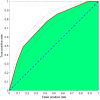Multidimensional variability in ecological assessments predicts two clusters of suicidal patients
- PMID: 36864070
- PMCID: PMC9981613
- DOI: 10.1038/s41598-023-30085-1
Multidimensional variability in ecological assessments predicts two clusters of suicidal patients
Abstract
The variability of suicidal thoughts and other clinical factors during follow-up has emerged as a promising phenotype to identify vulnerable patients through Ecological Momentary Assessment (EMA). In this study, we aimed to (1) identify clusters of clinical variability, and (2) examine the features associated with high variability. We studied a set of 275 adult patients treated for a suicidal crisis in the outpatient and emergency psychiatric departments of five clinical centers across Spain and France. Data included a total of 48,489 answers to 32 EMA questions, as well as baseline and follow-up validated data from clinical assessments. A Gaussian Mixture Model (GMM) was used to cluster the patients according to EMA variability during follow-up along six clinical domains. We then used a random forest algorithm to identify the clinical features that can be used to predict the level of variability. The GMM confirmed that suicidal patients are best clustered in two groups with EMA data: low- and high-variability. The high-variability group showed more instability in all dimensions, particularly in social withdrawal, sleep measures, wish to live, and social support. Both clusters were separated by ten clinical features (AUC = 0.74), including depressive symptoms, cognitive instability, the intensity and frequency of passive suicidal ideation, and the occurrence of clinical events, such as suicide attempts or emergency visits during follow-up. Initiatives to follow up suicidal patients with ecological measures should take into account the existence of a high variability cluster, which could be identified before the follow-up begins.
© 2023. The Author(s).
Conflict of interest statement
The authors declare no competing interests.
Figures





References
Publication types
MeSH terms
LinkOut - more resources
Full Text Sources
Medical
Research Materials

